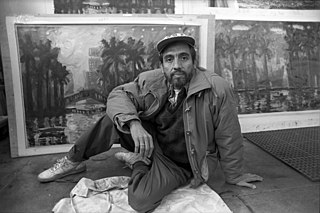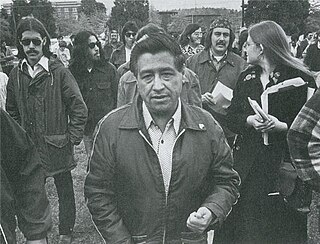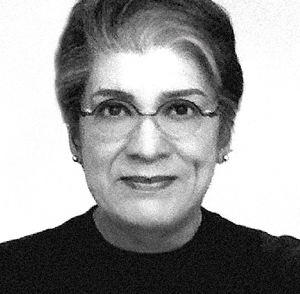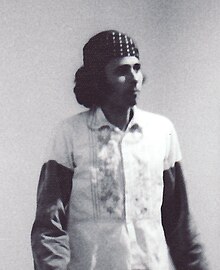
The Royal Chicano Air Force (RCAF) is a Sacramento, California-based art collective, founded in 1970 by Ricardo Favela, José Montoya and Esteban Villa. It was one of the "most important collective artist groups" in the Chicano art movement in California during the 1970s and the 1980s and continues to be influential into the 21st century.

Carlos D. Almaraz was a Mexican-American artist and a pioneer of the Chicano art movement. He was one of the founder of the Centro de Arte Público (1977–1979), a Chicano/Chicana arts organization in Highland Park, Los Angeles.

Gronk, born Glugio Nicandro, is a Chicano painter, printmaker, and performance artist. His work is collected by museums around the country including the Smithsonian American Art Museum.

The Chicano Movement, also referred to as El Movimiento, was a social and political movement in the United States that worked to embrace a Chicano/a identity and worldview that combated structural racism, encouraged cultural revitalization, and achieved community empowerment by rejecting assimilation. Chicanos also expressed solidarity and defined their culture through the development of Chicano art during El Movimiento, and stood firm in preserving their religion.

Los Four was a Chicano artist collective active based in Los Angeles, California. The group was instrumental in bringing the Chicano art movement to the attention of the mainstream art world.

The Centro Cultural de la Raza is a non-profit organization with the specific mission to create, preserve, promote and educate about Chicano, Mexicano, Native American and Latino art and culture. It is located in Balboa Park in San Diego, California. The cultural center supports and encourages the creative expression “of the indigenous cultures of the Americas.” It is currently a member of the American Alliance of Museums.

Chicana feminism is a sociopolitical movement, theory, and praxis that scrutinizes the historical, cultural, spiritual, educational, and economic intersections impacting Chicanas and the Chicana/o community in the United States. Chicana feminism empowers women to challenge institutionalized social norms and regards anyone a feminist who fights for the end of women's oppression in the community.
Gilbert "Magu" Luján was a Chicano American sculptor, muralist, painter, and educator. He was a founding member of the Chicano collective, Los Four that consisted of artists Carlos Almaraz, Beto de la Rocha, Frank Romero and himself. In 1974, Judithe Hernández became the "fifth member," and only female member of Los Four.

Judithe Hernández is an American artist and educator, she is known as a muralist, pastel artist, and painter. She is a pioneer of the Chicano art movement and a former member of the art collective Los Four. She is based in Los Angeles, California and previously lived in Chicago.

The Chicano Art Movement represents groundbreaking movements by Mexican-American artists to establish a unique artistic identity in the United States. Much of the art and the artists creating Chicano Art were heavily influenced by Chicano Movement which began in the 1960s.
Patssi Valdez is an American Chicana artist. She is a founding member of the art collective Asco. Valdez's work represents some of the finest Chicana avant-garde expressionism which includes but not limited to painting, sculpture and fashion design. She lives and works in Los Angeles, California.
Willie F. Herrón III is an American Chicano muralist, performance artist and commercial artist.

Chicano Art: Resistance and Affirmation was a traveling exhibit of Chicano/a artists which toured the United States from 1990 through 1993. CARA visited ten major cities and featured over 128 individual works by about 180 different Chicano/a artists. The show was also intended to visit Madrid and Mexico City. CARA was the first time a Chicano exhibit received major attention from the press and it was the first exhibit that collaborated between Chicanos and major museums in the U.S. The show was considered a "notable event in the development of Chicano art." Another unique feature of CARA was the "extensive planning" that attempted to be as inclusive as possible and which took place more than five years prior to the opening at Wight Art Gallery.
Victor Ochoa is an activist, painter, graphic designer and master muralist. He has painted over 100 murals, many of them in San Diego, California. He is considered one of the pioneers of San Diego's Chicano art movement. Ochoa was one of the original activists at Chicano Park and a co-founder of Centro Cultural de la Raza in Balboa Park, both in San Diego. He helped establish the influential Border Art Workshop/Taller de Arte Fronteriza (BAW/TAF). Ochoa is also a teacher of art and Chicano heritage. His work has been shown nationally and internationally, including at the Venice Bi-Annual, at the Museum of Contemporary Art, San Diego and in the groundbreaking exhibition, Chicano Art: Resistance and Affirmation (CARA). In addition to creating his own work, he is also a master of art preservation techniques, especially relating to murals. He is considered to be a "serious cultural resource in the border region.

Chicana art emerged as part of the Chicano Movement in the 1960s. It used art to express political and social resistance through different art mediums. Chicana artists explore and interrogate traditional Mexican-American values and embody feminist themes through different mediums such as murals, painting, and photography. The momentum created from the Chicano Movement spurred a Chicano Renaissance among Chicanas and Chicanos. Artists voiced their concerns about oppression and empowerment in all areas of race, gender, class, and sexuality. Chicana feminist artists and Anglo-feminist took a different approach in the way they collaborated and made their work during the 1970s. Chicana feminist artists utilized artistic collaborations and collectives that included men, while Anglo-feminist artists generally utilized women-only participants. Art has been used as a cultural reclamation process for Chicana and Chicano artists allowing them to be proud of their roots by combining art styles to illustrate their multi-cultured lives.

The Cheech Marin Center for Chicano Art & Culture, known as The Cheech, is a museum in Riverside, California. It is part of the larger Riverside Art Museum. The center is focused on the exhibition and study of Chicano art from across the United States. This is a collaborative effort between Cheech Marin, the City of Riverside and Riverside Art Museum. Cheech Marin is a stand-up comedian, actor, writer, and collector. He has donated or promised his collection of more than 700 pieces of Chicano art. Riverside provides the old Riverside public library to house the collection and the Riverside Art Museum manages the center. The Cheech strives to be a world-class institution for the research and study of "all things [related to] Chicano art". It is the first North American museum facility dedicated exclusively to Mexican-American and Chicano art.

A Mexican American is a resident of the United States who is of Mexican descent. Mexican American-related topics include the following:

Charles "Chaz" Bojórquez is an American Chicano graffiti artist and painter who is known for his work in Cholo-style calligraphy. He is credited with bringing the Chicano and Cholo graffiti style into the established art scene. He began his art career by tagging in his neighborhood of Highland Park, Los Angeles in the early 1970s. In his youth, Bojórquez was given the tag Chaz, which meant "the one who messes things up and likes to fight."
Frank Edward Romero is an American artist considered to be a pioneer in the Chicano art movement. Romero's paintings and mural works explore Chicano and Los Angeles iconography, often featuring palm trees and bright colors.
Lucila Villaseñor Grijalva is a Chicana muralist who was born in Los Angeles, California. Her art style is inspired by graffiti art.











